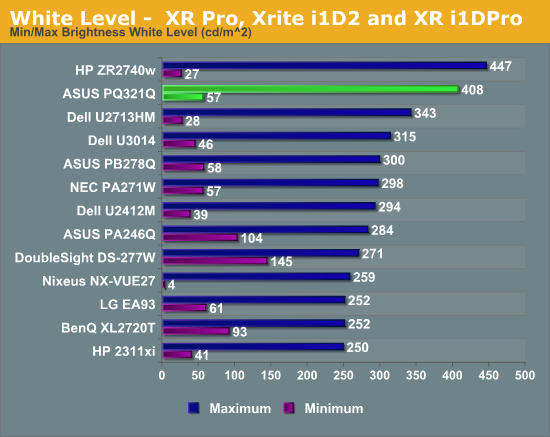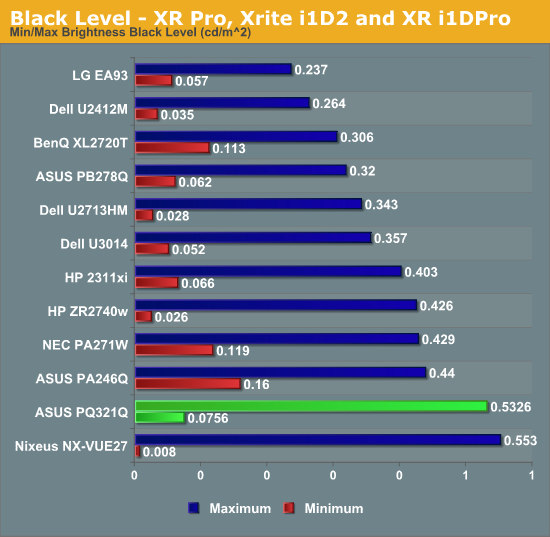ASUS PQ321Q UltraHD Monitor Review: Living with a 31.5-inch 4K Desktop Display
by Chris Heinonen on July 23, 2013 9:01 AM ESTSince the ASUS has a pair of HDMI inputs, but there is effectively no 4K HDMI content right now, the performance of the internal scaler is essential to know. To test it, I use an Oppo BDP-105 Blu-ray player and the Spears and Munsil HD Benchmark, Version 2. The Oppo has its own 4K scaler so I can easily compare the two and see how the ASUS performs.
First off, the ASUS is poor when it comes to video processing. Common film and video cadences of 3:2 and 2:2 are not properly picked up upon and deinterlaced correctly. The wedge patterns are full of artifacts and never lock on. With the scrolling text of video over film, the ASUS passed which was strange as it fails the wedges. It also does a poor job with diagonals, showing very little if any filtering on them, and producing lots of jaggies.
Spears and Munsil also has a 1080p scaling pattern to test 4K and higher resolution devices. Using the ASUS scaler compared to the Oppo it had a bit more ringing but they were pretty comparable. This becomes very important for watching films or playing video games, as you’ll need to send a 1080p signal to get a 60p frame rate. 24p films will be fine, but concerts, some TV shows and some documentaries are 60i and would then appear choppy if sent at 4K over HDMI.
Brightness and Contrast
In our preview of the PQ321Q, we looked at how it performed out of the box with the default settings. What we did see is that the PQ321Q can get really, really bright. Cranked up to the maximum I see 408 cd/m2 of light from it. That is plenty no matter how bright of an office environment you might work in. At the very bottom of the brightness setting you still get 57 cd/m2. That is low enough that if you are using it for print work or something else in a darkened room the brightness won’t overwhelm you.

The change to IGZO caused me to wonder how the black levels would behave on the ASUS. If energy flows far more freely, would that cause a slight bit of leakage to lead to a higher black level? Or would the overall current be scaled down so that the contrast ratio remains constant.
I’m not certain what the reason is, but the black level of the PQ321Q is a bit higher than I’d like to see. It is 0.756 cd/m2 at the lowest level and 0.5326 cd/m2 at the highest level. Even with the massive light output of the ASUS that is a bit high.

Because of this higher black level, we see Contrast Ratios of 755:1 and 766:1 on the ASUS PQ321Q. These are decent, middle-of-the-pack numbers. I really like to see 1,000:1 or higher, especially when we are being asked to spend $3,500 on a display. Without another IGZO display or 4K display to compare the ASUS to, I can’t be certain if one of those is the cause, or if it is the backlighting system, or something else entirely. I just think we could see improvements in the black level and contrast ratio here.











166 Comments
View All Comments
cheinonen - Tuesday, July 23, 2013 - link
And then after that you're going to sell far fewer, so your profit margins are going to have to change to adapt for that as well, and it really winds up making them far more expensive. It really is the best looking display I've used and the one I most want to keep around after the review period. Companies should be rewarded for taking the risk in releasing niche products that help push the market forward, and really are a breakthrough.Sivar - Tuesday, July 23, 2013 - link
Ideally they can cut 3 good 15" displays from the failed 30" material.Whether the process actually works this way, I don't know.
madmilk - Tuesday, July 23, 2013 - link
It doesn't work that way. That's like saying Intel can cut a quad core CPU into two dual core CPUs.sunflowerfly - Wednesday, July 24, 2013 - link
Where do you think Intel gets lower core count CPU's? They actually do disable cores and sell them for lower spec parts.DanNeely - Thursday, July 25, 2013 - link
They've done so in the past, and IIRC still do bin GPU levels that way; but in all their recent generations the dual and quad core CPUs that make up 99% of their sales have been separate dies.Your analogy breaks down even for the handful of exceptions (single core celeron, quadcore LGA2011); since the LCD equivalent would be to sell you a 15" screen in a 30" case with a huge asymmetric bezel covering 3/4ths of the panel area.
Calista - Thursday, July 25, 2013 - link
It's not just the parts getting more expensive to manufacture, it's also because the manufacturer knows it's a high-margin product. The difference in price for an APS-C vs an FF sensor is on the order of a magnitude smaller than the difference in price between the complete cameras, i.e. $500 vs $2500, even if the FF camera obviously also include faster processing, higher quality body etc.YazX_ - Tuesday, July 23, 2013 - link
companies would like like to milk users as its brought to Desktop marketed as NEW TECH, this is the only reason why its very pricey, and dont forget that on the next months other companies will bring their products into competition which will help greatly in reduce the prices.Fleeb - Tuesday, July 23, 2013 - link
This reply is better than yours: http://www.anandtech.com/comments/7157/asus-pq321q...madmilk - Tuesday, July 23, 2013 - link
No worries, there's a 4K 39" TV on Amazon for $700. Since that TV has the same number of pixels and isn't a whole lot bigger, I think we will soon be seeing these 32" displays fall into that sub-$1000 range as well.peterfares - Wednesday, July 24, 2013 - link
That screen is lower quality and doesn't have an input capable of driving it at 60Hz at 4K